Little Skate
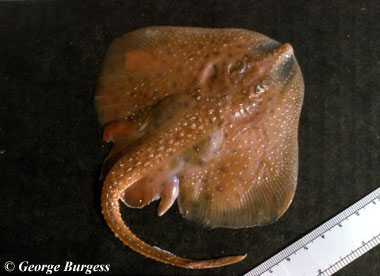
Leucoraja erinacea
These little skates have very rounded diamond-shaped pectoral discs that are dark brown or grey with cloudy splotches, and white to grey undersides. They grow to around 20 inches long, and have thorny spines on shoulders, tails, and backs–sometimes more or less thorns depending on age and sex.
These skates have an electrosensory organ on their heads, and can create very weak electric fields with an organ in their tails, but these are used for locating food and possibly communicating to mates. They are not considered a threat to humans and only have caused harm if stepped on.
Order: Rajiformes
Family: Rajidae
Genus: Leucoraja
Species: erinacea
Common Names
English language common names include hedgehog skate, little common skate, little skate, summer skate, and tobacco box skate. Other common names include kleine rog (Dutch), raiae-de-verão (Portuguese), raie hérisson (French), raja kanadyjska (Polish), and vatos mic (Rumanian).
Importance to Humans
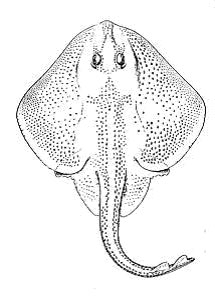
Historically, this species has not been that commercially important. However, they are used often to bait traps, especially lobster and eel traps. There has been some marketing of skate meat as scallops using round cuts from the skate wings. There is potential for over-exploitation since they have low levels of reproduction and mature relatively late, like most Elasmobranchs.
Danger to Humans
There is little danger associated with the little skate. Unlike most stingrays, skates do not have venomous spines. Skates do have thorns that might cause injury to a person if stepped on or picked up.
Conservation
> Check the status of the little skate at the IUCN website.
According to the International Union for Conservation of Nature and Natural Resources (IUCN), the little skate is not listed as endangered or vulnerable. The IUCN consists of a global union of state, governmental agencies, and non-governmental organizations in partnership whose goal is to assess the conservation status of different species.
Geographical Distribution
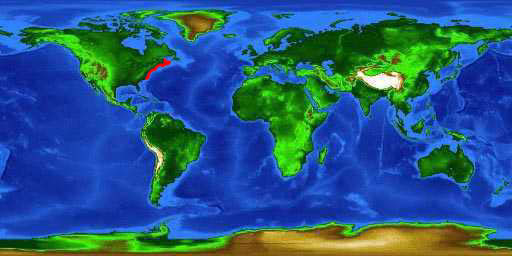
The little skate can be found in the western Atlantic Ocean. They range from the southern Gulf of St. Lawrence and Nova Scotia in Canada to North Carolina, USA.
Habitat
This species is typically found on sandy or gravely bottoms from shallow waters to 295.28 feet (90 m) deep. They are most active during daylight hours. The little skate can tolerate a wide range of temperatures, from 89.6ºF (32ºC) to 158ºF (70ºC). The little skate can tolerate salinity ranges of 27 0/00 to 33.8 0/00 but their optimal range is 29 0/00 to 33 0/00. There are no reports of this species being found in freshwater and ones that have been placed in freshwater show physiological problems. The little skate does not appear to have large-scale migrations but they do move to shallower water during the summer and move to deeper water in fall or early winter.
Biology
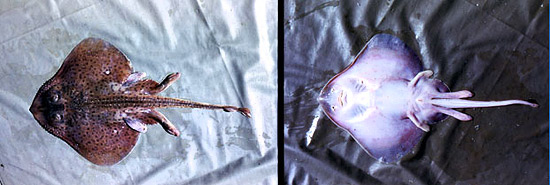
Distinctive Features
The little skate has a very rounded snout and wings with a blunt nose. The two dorsal fins are located close together on the tail. The tail length for newly hatched young is about 1.1 times the length of the body (from snout to cloaca) but decreases as they reach adulthood to about 0.85 to 0.95 the length of the body.
The little skate possesses an electrosensory known as ampullae of Lorenzini. This organ is found on the head and consists of many tiny gel filled canals. This organ allows it to detect weak electric fields produced by its prey. It is also believed that this organ might function like a compass with the earth’s magnetic field. This species also has electric organs on the tail that consists of electrocytes but it produces weak electric fields. It is suspected that these electric organs are used more for conspecific communication and possibly mate location.
There has been one unusual specimen found near Fisher’s Island, NY that showed hermaphroditism, which is extremely rare among elasmobranch fishes. The left side of the body contained large well-developed testis, vas deferens, and functional clasper while the right side had tiny/abortive clasper, adolescent ovary, shell gland, and a mature oviduct.
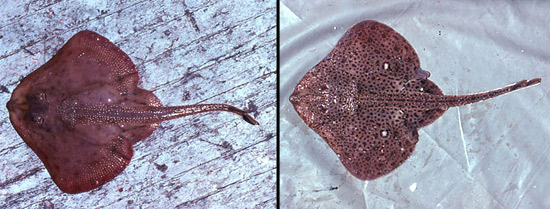
Coloration
The dorsal surface ranges from grayish to dark brown or clouded light and dark brown. The edges of the pectoral fins are paler. There are usually small round darker spots found on the dorsal surface. The ventral surface is white or grayish. The tail has either irregular dusky blotches or dark gray lower surface.
While the winter skate (Leucoraja ocellata) typically has oscillated spots, individuals that lack these spots are often confused with little skates.
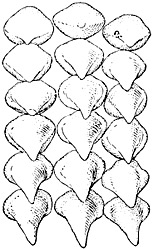
Dentition
The teeth of the little skate consist of about 38 to 66 series on jaw plates. The teeth are round shaped with faint transverse cutting edges. They use the teeth for grinding food between the two plates.
Denticles
When it is fully-grown, they are relatively small and no thorny spines are present along the midline of the back (unlike the young of this species). Females have spines scattered on the upper surface that are prominent on the head, snout, shoulders, and sides of the tail. Typically, spines are not found on the midline, back of the shoulder girdle but there have been exceptions to this generalization. Males tend to have fewer spines than the females since males lose most of the thorns from the inner parts of the pectorals and some from the mid-dorsal ridge as they mature. The spines that are located on the tail, shoulder, and on either side of the ridge of the back are quite strong in both sexes.
Size, Age, and Growth
The little skate commonly reach 16 to 20 inches (40.6-50.8 cm) long but a maximum size of 21 inches (54 cm) has been recorded. The disc is about 1.2 times as wide as it is long. At 16 to 17 inches (40.6-43.2 cm), they weigh about 3/4 to 1 pound (0.34-0.45 kg) and can weigh from 1 1/3 to 2 pounds (0.59-0.91 kg) at 18 inches long. Little skates that are 8 inches (20 cm) long may be 1 to 1 1/2 years old, 11 3/4 to 12 inches (30 cm) 2-3 years, 15 3/4 to 16 inches (40 cm) 3 to 4 years, 19 3/4 to 20 inches (50cm) 6 to 8 years old. The mortality rate for this species seems to be very high after five years since very few that have been captured are longer than 18 to 19 inches. Females reach sexual maturity at 12 1/2 to 17 inches (32-43 cm), while males reach it at about 14 to 17 1/4 inches (35.5-43.8 cm) long.
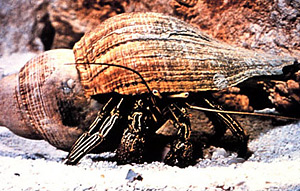
Food Habits
Common prey items include hermit and other crabs, shrimps, worms, amphipods, ascidians (sea squirts), bivalve mollusks, squid, small fishes, and even some copepods.
Reproduction
Little skates are oviparous (egg layers). The male uses two long claspers, along the pelvic fins, to aid in transmitting sperm. They are known to copulate many times throughout the year and frequently. There seems to be a higher frequency of pregnant little skates from October to December and April to May while there is a low frequency from August to September and February to March. Eggs are laid throughout the year but appear to be highest from October to January and June to July.
The egg capsule is amber or golden yellow when they are first laid. The oblong capsules have stiff pointed horns at the corners and are either deposited on sandy or muddy flats or attached to seaweed. The egg capsules are 1.8-2.5 inches (4.6-6.3 cm) long and 1-2 inches (2.7-4.8 cm) wide, and the female lays about 10-35 eggs annually. Yolk within the egg capsule contains all of the organic materials necessary for development until hatching. It takes about 5 to 6 months for the young to hatch under aquarium conditions. It is expected to be longer in nature, especially during autumn and early winter because of cooler temperatures.
The young skates emerge from the capsule through a transverse opening at the edge with the longer pair of horns. The length of the young when hatched is about 3 ¾ to 4 inches (10 cm), its abdomen is still swollen with yolk, and the whiplash-like extension on the tail disappears within a few days. The whiplash-like embryo tail is believed to be used for water circulation in the capsule. After the young skates have hatched, the empty black capsules wash ashore.
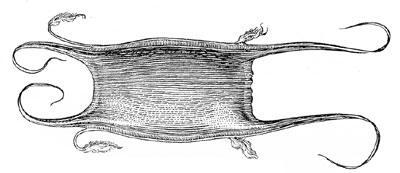
Predators
Predators of the little skate include sharks, especially the sandbar shark (Carcharhinus plumbeus); other skates including the winter skate (Leucoraja ocellata); and gray seals.
Parasites
The little skate is plagued by a variety of parasites. Protozoan parasites include Caliperia brevipes, Haemogregarina delagei, and Trypanosoma rajae. Chloromyxum leydigi and Leptotheca agilis are members of Myxosporida parasites. Pseudanisakis tricupola is the only species of nematodes to parasitize them. Eudactylina corrugata and Lernaeopodina longimana are members of Copepoda that have been found as well.
Taxonomy
The little skate was first named Raja erinacea (Mitchill, 1825). This name was changed to the currently valid name Leucoraja erinacea that same year. The genus name is derived from the Greek “leukós” meaning white and from the Latin “raja” meaning stingray. No synonyms are known for this species.
Prepared by: Kimberly Kittle